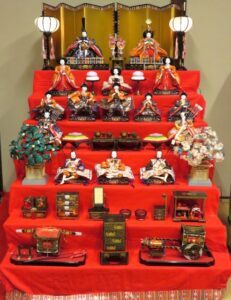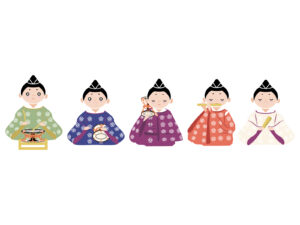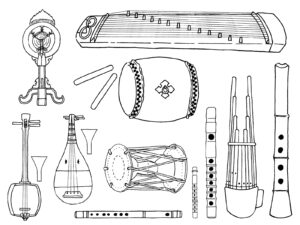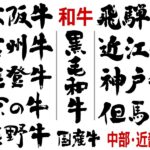Contents
What is Gagaku - Japanese classic music
It's only recent that I paid attention to this genre of music. Most Japanese know or have heard of the term "Gagaku", but probably most do not know much about it just like I didn't.
This article is written based on bits and pieces of information I gathered, but history and detail of this unique music style is so vast that you can easily spend years researching and reading about it.
When you hear the word "Gagaku", the first image that comes to mind would be the "unique slow stretching sound of unknown instruments played at Japanese style wedding held at shrines.
One other common image is the 5 Gagaku players in "Hina-ningyō" which is shown here. This is a set of dolls displayed only for "Hina-maturi/girls' festival (March 3)".
 Typical arrangement for the dolls are:
Typical arrangement for the dolls are:
- Top row for the emperor and the empress (or Shogun and his wife).
- The second row for the 3 court ladies
- The third row for the 5 musicians (these are the Gagaku players)
- The fourth row for the 2 ministers (like body guards)
- The fifth row for the 3 staff workers
- The sixth and seventh for tiny replica furniture and equipments
Some households display all 7 rows/steps, and some only the top row or top 3 or 5 rows. Each region in Japan may have their own unique way of arranging and displaying Hina-ningyō.
The 5 men on the 3rd row are called "Gonin-bayasi・ごにんばやし・五人囃子" meaning 5 musicians. These are the Gagaku players, 3 of them hold drums, one holds flute, and one holds a fan (this is the singer).
Gagaku background - how it came about
Gagaku is an Ancient Japanese music, some blended with music brought over from overseas, primarily China, Korea, India, and Vietnam. The unique style of Gagaku was established in Heian era (794-1185) when capital was in Kyoto.
"Gagaku" literally means "gorgeous music". It's an official music for imperial family, and back in time, it was appreciated by high society as opposed to "Zokugaku・ぞくがく・俗楽” which is lay people's music.
Gagaku is played by 3 types of instruments: wind, strings, and percussion. When performed by a large number of players, the formation is similar to that of orchestra without a conductor standing in front.

Why Gagaku now? Fascinating sound of Hitiriki/bamboo flute
History and detail of Gagaku is intriguing for sure, but what really captured my heart was the sound of Hitiriki played by Hideki Tōgi, one of the most famous, popular and authentic Gagaku performers in Japan today.
What's unique about him is that, in an effort to revive and spread Gagaku music to the world, he arranges modern music pieces and collaborates with Gagaku instruments. The performance below (Youtube video) is a Japanese song that everyone knows but never played with Gagaku instrument before.
It's hard to explain the tone of Hitiriki (bamboo flute). It's so serene, transparent yet faintly hoarse, and very emotional. Once you hear it, you won't forget it.
Here, Hideki Tōgi plays the Hitiriki while his son, Norichika, plays the "Syō" (mini pipe organ like instrument made with bamboo). Hope you like it.
(ref: "gagaku" in wikipedia; The Japan Gagaku Society website)
See you next time! 
Please note




